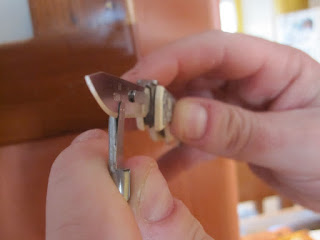Part 1 got us to a point where we have the basic outside shape of the call. All we have to do now is sand and finish, drill-out both sides of the call, and install the reed. Below is an abbreviated version of the basic steps to finish the call.
I added a couple of stripes using wood puddy and sanded the call to 1000 grit. I don't have the patients to laminate wood, so to achieve a similar look I make a couple of notches in the call and fill them with a light colored wood putty. This is a fast and easy way to add a custom look to your call.
Use a 5/8" Forstner bit to drill out the call barrel
After drill out your call, use a parting tool remove wood from the inside bell part of your call.
Call shown here drilled-out, sanded, wiped with acetone, and finished with a Liberon wax stick.
Removing the call from the original block we started with.
Now drill out the "stopper" end of the call using a step-bit.
Finish drilling the last 1/2" using a regular 9/32" twist bit.
Install the reed sleeve, tune the reed using a razor blade, and give your call a test.
To get a lower pitch with your call slightly bend the reed away from the tone-board. A higher pitched sound can be achieved by applying a small vertical crease to the center of the reed. This may take some trial and error, but is important in achieving the sound you are looking for.
The call is now finished. The use of a reed sleeve on this call allows me to remove the reed, clean it, tune it, or change it completely. This gives the flexibility to change the sound depending on the game I am calling.
As a postscript, I will admitt that the quote by Abraham Maslow, "To the man who only has a hammer in the toolkit, every problem looks like a nail", best describes my approach to making calls. My call making method was born out of the limited tools I had at my disposal. With that said, I believe that the steps above are the easiest way to make a predator call and I can garauntee that if used properly a call made this way can be effective on bear, lion, coyote, bobcat, fox, etc.
My very first predator call from 2001. Made from desert ironwood.
A couple of bears called to within range using garage-made calls:

















